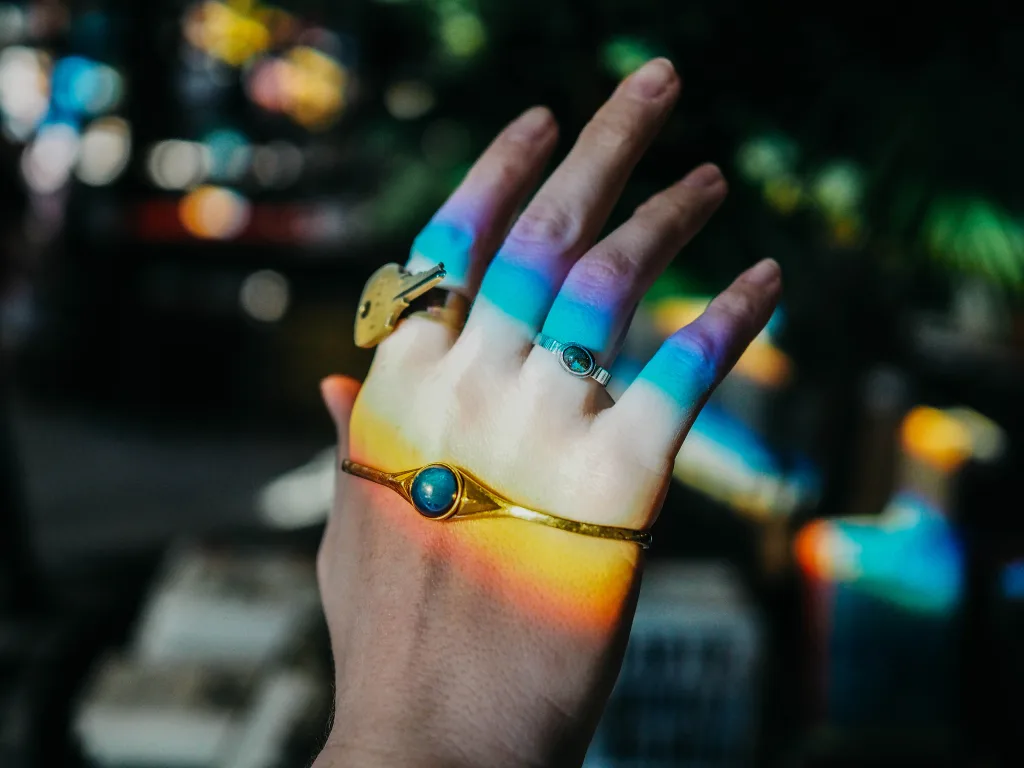Mood rings have been around since the 1970s, and they continue to fascinate people. But are mood rings real? Can they atually tell us something about our emotions?
The answer is yes and no. Mood rings do reflect real changes in body temperature that can occur in response to our emotions, but they can’t tell us anything we don’t alredy know.
At the heart of a mood ring is a flat strip of liquid crystals with a protective coating. When the temperature of your finger changes due to your emotions, these crystals twist, which alters the wavelengths of light they absorb or reflect. This is what causes the mood ring to change color.
So while mood rings can give us an indication of our emotional state, it’s important to remember that they are only providing a visual representation of what we already know—that our emotions affect our body temperature. They cannot read our minds or tell us anything about our feelings that we don’t already know.
In short, mood rings are interesting pieces of jewelry that can provide an indication of our emotional state, but they should not be seen as reliable sources of information about our feelings and emotions. If you want to gain more insight into your feelings and emotions, it’s best to talk to a mental health professional or trusted friend or family member.
Accuracy of Mood Rings
Mood rings are generally considered to be more of a novelty item than a reliable indicator of your emotional state. The concept beind mood rings is that they use thermotropic liquid crystals to measure your body temperature and display the result as a color that reflects your current emotional state. However, the accuracy of mood rings as an indicator of emotion is questionable. While changes in body temperature can reflect emotional states, they are too subtle to be accurately measured by a mood ring. Additionally, there is no specific correlation between each color and an emotion. Therefore, while mood rings may change color depending on fluctuations in body temperature, it is not reliable enough to accurately assess one’s emotional state.

How Mood Rings Function
Mood rings are made from liquid crystals that are sealed in a thin, clear quartz shell. The liquid crystals contain molecules that twist and untwist when exposed to changes in temperature. This twisting of the molecules causes them to absorb and reflect different wavelengths of light, creating an array of colors. The color change corresponds to the wearer’s body temperature, which indicates teir emotional state. A cool body temperature usually results in a blue or green hue, while a warmer temperature often produces more vibrant colors such as yellow or pink. While mood rings can be fun to wear and interpret, it is important to remember that the colors produced are only an indication of emotions on the surface level and should not be taken as an accurate assessment of one’s true feelings.
Do Real Mood Rings Actually Exist?
Yes, real mood rings do exist. They are made from thermotropic liquid crystals, which change color based on the temperature of the wearer’s finger. When a person wears a mood ring, the heat from ther finger changes the shape of the crystal molecules, causing the ring to change color. Depending on the color of the mood ring, it can indicate different emotions such as happiness, anger, and sadness.
Are Mood Rings a Natural Phenomenon?
No, mood rings are not natural. While some of the liquid crystals used in mood rings can be derived from natural sources, they are typically synthesized in a lab. The crystals are made from organic polymers and oten contain thermochromic dyes, which change color with temperature. This means that when the ring is worn and body heat is applied, the color of the crystal changes to indicate a person’s emotional state.
What Causes My Mood Ring to Always Appear Black?
Your mood ring cold be consistently showing a black color due to poor circulation. This can be caused by a number of things, such as: low body temperature, anemia, or other medical conditions. Additionally, it could be caused by wearing the ring too tightly or exposing it to extreme temperatures. If you believe your mood ring is always displaying a black color due to poor circulation, try taking it off and warming up your finger with a hairdryer or using lotion to increase blood flow before putting it back on. Additionally, make sure that the ring is not too tight so that your finger can still breathe.

Source: aliexpress.com
The Toxicity of Mood Rings
No, a mood ring is not typically toxic. Mood rings are usualy made from glass or plastic and do not contain any hazardous materials. However, some types of metal rings and necklaces that are used to accessorize mood rings may contain high levels of lead, which can be toxic if ingested by children. Therefore, it is important to ensure that any metal pieces worn with a mood ring are lead-free.
The Meaning Behind a Consistently Purple Mood Ring
Your mood ring is likely always purple because purple is a color that typically signifies passion and excitement. Purple also can indicate an elevated state of energy and enthusiasm, as well as joy and happiness. This could be why your mood ring is oftn seen in the color purple; because you are often in a passionate, excited, or joyful state.
The Accuracy of Mood Rings
The most accurate mood ring is the HONEYCAT Mood Ring. This ring features a special thermochromic liquid crystal stone that reacts to body temperature to accurately reflect your current emotional state. The stone is set in a stainless steel band that is adjustable for a comfortable fit, and it also has an adjustable chain for added security. The colors range from light blue (happy and relaxed) to dark green (tense and stressed). This ring can be worn as a fashionable piece of jewelry or used as a tool to monitor your emotional state. It’s sure to make a great gift for thse who need help regulating their emotions.
Activating a Mood Ring
A mood ring is an accessory that changes color based on the temperature of the wearer’s skin. It works by using thermotropic crystals, which are sensitive to heat and move in response to it. To activate a mood ring, you will need to wear it on your finger for severl minutes. The heat from your body will cause the crystals to move and change the color of the stone. Depending on the temperature of your skin, the stone can change from dark blue (happiness) to black (stress or anxiety). The intensity and shade of color can also indicate other emotions like excitement or calmness.

The Mystery of the Mood Ring
A mood ring contains a thermochromic element, oten referred to as a “mood stone”. This element is usually made up of liquid crystals that are sensitive to temperature. When the temperature of the ring changes due to the body temperature of the wearer, the liquid crystals rearrange and reflect light differently, causing the color of the ring to change. The colors can range from blues and purples for colder temperatures to reds and oranges for warmer temperatures.
Conclusion
In conclusion, mood rings are real and do have some scientific basis. They are made from liquid crystals that twist in response to changes in temperature, which can be caused by emotional states. However, the accuracy of the color changing and its ability to tell you something aout your emotions is questionable. Ultimately, mood rings can be a fun fashion accessory, but they shouldn’t be taken too seriously as a way to understand your feelings.
